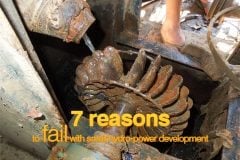Clean energy future
One of the questions most often asked about wind power is ‘what happens when the wind doesn’t blow’. In the big picture wind is a vast untapped resource capable of supplying the world’s electricity needs many times over.
In practical terms, in an optimum, clean energy future, wind will be an important part of a mix of renewable energy technologies, playing a more dominant role in some regions than in others. However, it is worthwhile to step back for a minute and consider the enormity of the resource.

Researchers at Stanford University’s Global Climate and Energy Project recently did an evaluation of the global potential of wind power, using five years of data from the US National Climatic Data Center and the Forecasts Systems Laboratory 1). They estimated that the world’s wind resources can generate more than enough power to satisfy total global energy demand.
After collecting measurements from 7,500 surface and 500 balloon-launch monitoring stations to determine global wind speeds at 80 metres above ground level, they found that nearly 13% had an average wind speed above 6.9 metres per second (Class 3), sufficient for economical wind power generation.
Offshore Resources
North America was found to have the greatest wind power potential, although some of the strongest winds were observed in Northern Europe, while the southern tip of South America and the Australian island of Tasmania also recorded significant and sustained strong winds. To be clear, however, there are extraordinarily large untapped wind resources on all continents, and in most countries; and while this study included some island observation points, it did not include offshore resources, which are enormous.
For example, looking at the resource potential in the shallow waters on the continental shelf off the densely populated east coast of the US , from Massachusetts to North Carolina, the average potential resource was found to be approximately four times the total energy demand in what is one of the most urbanized, densely populated and highest-electricity consuming regions of the world 2).
A study by the German Advisory Council on Global Change (WBGU), “World in Transition – Towards Sustainable Energy Systems” (2003) calculated that the global technical potential for energy production from both onshore and offshore wind installations was 278,000 T TWh (Terawatt hours) per year. The report then assumed that only 10–15% of this potential would be realisable in a sustainable fashion, and arrived at a figure of approximately 39,000 T TWh supply per year as the contribution from wind energy in the long term, which is more than double current global electricity demand.

The WBGU calculations of the technical potential were based on average values of wind speeds from meteorological data collected over a 14 year period (1979–1992). They also assumed that advanced multi-megawatt wind energy converters would be used. Limitations to the potential came through excluding all urban areas and natural features such as forests, wetlands, nature reserves, glaciers and sand dunes. Agriculture, on the other hand, was not regarded as competition for wind energy in terms of land use.
Looking in more detail at the solar and wind resource in 13 developing countries, the SWERA (Solar and Wind Energy Resource Assessment) project, supported by the United Nations Environment Programme, has found the potential, for instance, for 7,000 MW of wind capacity in Guatemala and 26,000 MW in Sri Lanka. Neither country has yet started to seriously exploit this large resource.
After this initial pilot programme, SWERA has expanded since 2006 into a larger programme with the aim of providing high quality information on renewable energy resources for countries and regions around the world, along with the tools needed to apply this data in ways that facilitate renewable energy policies and investments. The private sector is also getting into the resource-mapping business, with Seattle based 3Tier launching its ‘mapping the world’ programme in 2008, with the goal of making accessible resource assessments available for the entire world by 2010.
In summary, wind power is a practically unlimited, clean and emissions free power source, of which only a tiny fraction is currently being exploited.
SOURCE: Global Wind Energy Outlook 2008











This article did not answer my question. — Also, I have read that the windmills are more expensive to build than the am’t of electricity they produce, and that when they wear out, the materials are not recyclable, thus making more trash. If you answer, please specifically address my concerns instead of dancing around the subject.
Hi Edvard,
The information and data given in the article is very informative and good. But, I did not understand how article heading “What happens when the wind doesn’t blow?” and content is related?. Could you please explain me, whenever you are free.
Regards,
Gururaja A G
Article content is related to the title, maybe not directly, but linked more to the resource potential in global and its limitations in urban areas described in studies. You’re right, maybe I could’ve put some other title!
Thanks for noticing!
BR,
Edvard